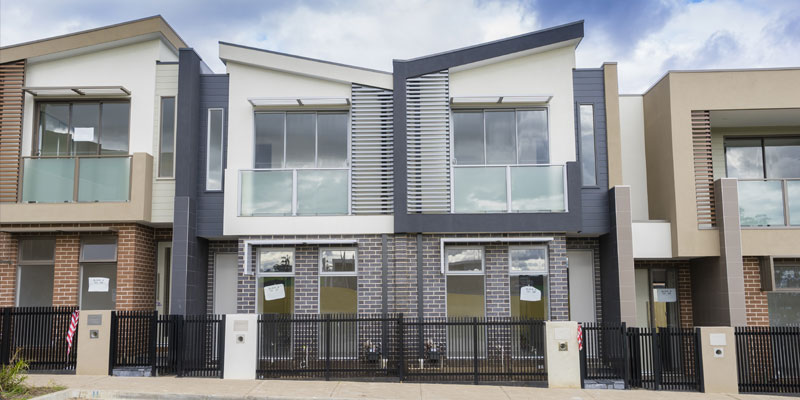Nine ways to improve houses for comfort, wellbeing and safety
By Professor of Environmental Mathematics John Boland
 ENVIRONMENT AND SUSTAINABILITY Newly built contemporary townhouses. Photo: Sunflowerey / Shutterstock.com
ENVIRONMENT AND SUSTAINABILITY Newly built contemporary townhouses. Photo: Sunflowerey / Shutterstock.comOne morning in early April, before sitting down to work in my newly laid out home office, I set out for a walk in my neighbourhood. Leaving our comfortable, renovated 1940s weatherboard house, surrounded by a lush, productive and climate protective garden, I observed new housing in the local area.
The differences between what I walked out of, and the newer houses being built that are of demonstrably poor quality in terms of climate resilience, led me to a question: “How should we react to the twin crises of the last few months?”
The climate change-exacerbated extreme bushfire season, followed closely on its heels by the COVID-19 pandemic, have underlined the importance of our home environments.
The first event emphasised why we need homes that can withstand and reduce severe heat and indeed fire. Secondly, the pandemic has demonstrated why our homes – where we have retreated to in recent weeks – need to be designed for our comfort, wellbeing and safety, especially if we are going to spend more time there.
Instead of focusing on the horrors of these crises, we can see them as a wakeup call and seize the opportunity to build resilience in our lives and society.
The one area where we can make great steps is to improve the liveability of people’s homes and the surrounding environment. In the houses newly built or still being built, there are a number of glaring errors, including:
- Houses being lumped together, taking up the majority of the tiny blocks, leaving no room for surrounding vegetation, or for proper ventilation;
- Black roofs increasing the heat load on the interior;
- Skimping on building shell, including no double glazing;
- Ignorance of simple passive design principles, for instance, large windows on the west;
- One particularly silly example was plastic grass in front of the houses facing west.
These are but a few of the problems with modern buildings, in an era where there are simple measures we can take to make one’s home much more liveable, especially as we face warmer temperatures and the prospect of home working becoming the norm rather than the exception.
With new homes, we should do the following:
- Insulate all exterior walls, and ceilings, to keep the heat out in summer and inside in winter;
- Put reflective foil under a light-coloured roof, to keep the sun out;
- Make sure there is room for vegetation, deciduous for shading in summer, evergreen for cutting hot summer winds and providing a buffer for cold winter winds;
- Double glazing;
- Ceiling fans – relatively cheap and super effective.
When looking at housing design, we need to plan for the future climate, not the present. A six-star house under present conditions may only perform as a 4-5-star house under climate change effects.
Some things to keep in mind with existing houses:
- Examine where additional beneficial vegetation can be placed to mitigate against future heatwaves;
- Insulate walls if possible;
- Double glazing if retrofitting. If not possible, try high performance glazing;
- Ceiling fans – relatively cheap and super effective.
One wonders why these home designs are not taken up more widely. Is it lack knowledge of the science or simply a willful neglect of it?

All these measures will not only insulate us against extreme climate events, but also build resilience in the case of future pandemics, where our homes could be the only safe haven. It’s important they are comfortable for both our physical and mental wellbeing.
This can be enhanced if our outdoor space can be transformed into a vegetable garden for home consumption, and also trading with or giving to friends.




